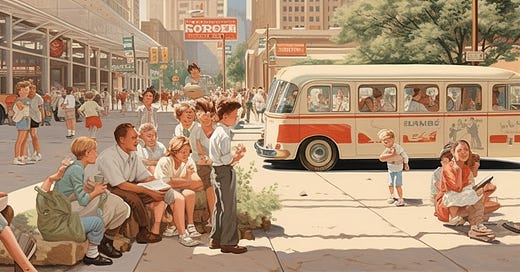The lobby of the Adolphus Hotel in Dallas would have me believe that Dallas was frequented by 20th-century aristocrats. To bring home this message, there is a framed letter from the dead queen of England, and an old-timey shoe shine stand that you can sit atop to prove that you are a man. This is just in case the colonial decor and staff who dress and speak like they are in a Wes Anderson movie was insufficient. These days the aristocrats have been replaced by flocks of men in polyester golf polos, the sonic environment filled by the crick crick of polyester stretching and contracting while they walk. The women's attires are more in touch with the colonial spirit or perhaps they'd rather be at the Kentucky derby but settled for The Adolphus hotel. This lobby is Dallas in a microcosm.
Dallas, as my friend Michael1 described, is like the New York City of Middle America. The pinnacle of middle-American aspirations of the 20th century. The built environment has me believe that this dream consists of driving 20 miles from your house in the suburbs, running over the site where JFK was assassinated into streets lined with high rises indistinguishable from one other. Inside one of these high rises lies the promise of being treated like an aristocrat for a few hours, finally getting the respect that you have deserved all your life for being a hard-working American. If you manage to spot someone walking on the sidewalk, be sure to treat them like the absolute vermin they decidedly are. The only thing standing between you and the middle American dream are poor and homeless people - the sworn enemy of every self-respecting American. Contrary to what you may believe, the middle American dream is also quite diverse. Places like Dallas and Houston draw significant numbers of middle-class immigrants re-enacting the 20th-century American dream, sometimes making scenes in Dallas streets look like a tableau of American life set in India or China.
Strolling through downtown Dallas while trying not to be run over by a blacked-out F-150, I had a minor epiphany about the infrastructure of middle-American cities. In Democracy in America, published in 1830, de Tocqueville had already diagnosed American culture as peculiarly devoted to easy sensation and mass-marketed entertainment, "spectacles vehement and untutored and rude" that aimed "to stir the passions more than to gratify the taste." The built environment of Dallas was the culmination of industrial mass optimization geared toward easy sensations for 200 years. This may seem to imply that people living in these types of cities are stupid and tasteless, but as David Foster Wallace writes in his essay on television and its influence on culture, "It is simply because people tend to be really similar in their vulgar and prurient and stupid interests and wildly different in their refined and moral and intelligent interests." So, it is not surprising to me that the built environment of middle American cities cater to the vulgar, prurient and stupid interests of its people.
People like me, who don't have enough money to buy a home and enjoy a different set of easy sensations, cope by looking at Dallas through the lens of sincere irony. Once you start looking at the featureless urban environment of Dallas through an ironic lens, it becomes more tolerable. The tourists taking selfies with the X marked at the JFK assassination site suddenly acquire the quality of performance artists. The unfriendly looks in a largely homogenous honky-tonk become more bearable because I'm not there sincerely. You are not watching me, just my ironic self that is witnessing you ironically.
My friend E recently hosted a film screening in Pflugerville. Among her goals for hosting regular screenings is a celebration of middle-American aesthetics. The movie being screened was Love on a Leash, a low-budget movie about a golden retriever that was once a man and now must find a woman who loves him in his dog form. Only then can he turn back into a man. As the premise might have implied, it is a movie that is sincerely made but can only be enjoyed ironically. The movie is made more contemporary middle American by the fact that it was made by a Chinese immigrant who moved to Los Angeles at the age of 45, then died after getting hit by a bus before the movie was released. The last sentence somehow covers all facets of middle American life in one swoosh. The middle American dream lives on and time will tell if it is tragedy or farce.
Earlier post Fast Cars Save Friendships feat. Michael


